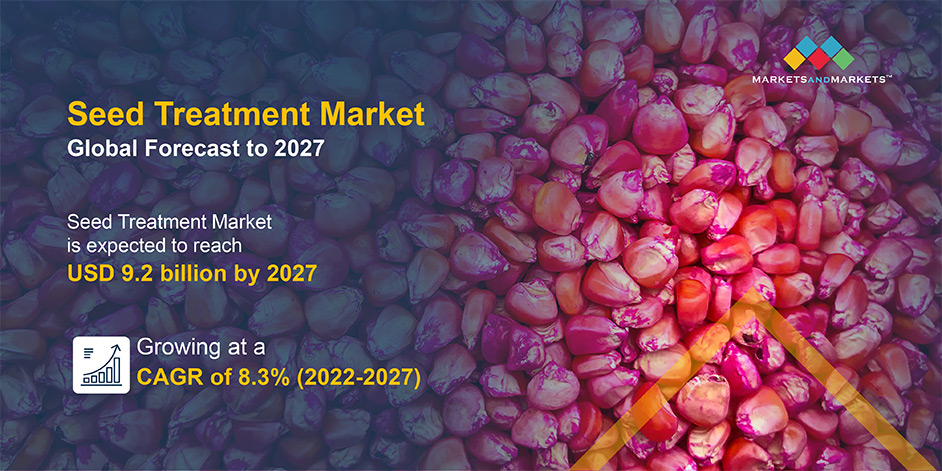The seed treatment market is on a remarkable growth path, projected to expand from $6.1 billion in 2022 to $9.2 billion by 2027, achieving a robust CAGR of 8.3%. This surge is fueled by a combination of critical factors—growing global concerns around food security, technological advancements, increased adoption of precision farming techniques, and strong governmental support. Together, these elements have cultivated a fertile environment for seed treatment solutions, enhancing crop yields, improving plant protection, and boosting agricultural efficiency.

Seed treatment is becoming an indispensable component of modern agriculture. Its ability to protect crops from pests and diseases while improving germination rates positions it as a key driver of sustainable and productive farming practices. With increased focus on quality and yield, the seed treatment industry is thriving—and its growth trajectory shows no signs of slowing down.
What is Seed Treatment?
Seed treatment refers to the application of chemical, biological, or physical agents to seeds before planting. These treatments are designed to protect seeds and seedlings from pathogens, pests, and environmental stressors, thereby improving germination rates, crop yield, and overall plant health.
There are several types of seed treatment methods, including:
- Chemical Treatments: Fungicides, insecticides, and nematicides.
- Biological Treatments: Beneficial microbes and biopesticides.
- Physical Treatments: Thermal, irradiation, or film coating technologies.
- Growing Need for High Crop Yield: With the global population projected to hit 9.7 billion by 2050, the demand for food is increasing rapidly. Seed treatments help farmers maximize productivity by ensuring healthier germination and early plant development.
- Rising Awareness of Sustainable Farming: Farmers are increasingly shifting to more eco-friendly agricultural practices. Biological seed treatments, in particular, are gaining popularity for their minimal environmental impact and ability to enhance soil health.
- Technological Advancements: Innovations such as nano-formulations, precision agriculture, and smart coatings are revolutionizing how seed treatments are developed and applied.
- Climate Change & Pest Pressure: Extreme weather and evolving pest resistance are pushing the need for more resilient agricultural practices. Seed treatment offers a proactive defense mechanism against these variables.
- Biological Seed Treatment Boom: Increasing regulatory pressure on chemical pesticides is accelerating the adoption of microbial and organic seed treatment solutions.
- Integration with Digital Farming: Companies are integrating seed treatment data with digital platforms for real-time monitoring and enhanced decision-making.
- Customized Solutions: Tailor-made treatments specific to crop type, region, and soil conditions are becoming increasingly popular.
- Emerging Markets: Countries in Asia-Pacific, Latin America, and Africa are witnessing rapid growth due to increased awareness and adoption of modern farming techniques.
By Crop Type: Fruits & Vegetables
The fruits and vegetables segment is expected to experience substantial growth during the forecast period. According to the Food and Agriculture Organization (FAO), the global production of fruits and vegetables has grown at an impressive 3% annually over the past decade. Consumption trends mirror this increase, especially as awareness of nutrition and healthy eating habits spreads worldwide.
The rising preference for organic produce is not only driving demand for traditional seed treatments but also accelerating growth in the biological seed treatment segment. Additionally, the cultivation of high-value crops like lettuce, spinach, hydroponic tomatoes, and bell peppers is creating a strong demand for tailored seed treatment solutions, particularly in controlled environments such as greenhouses and hydroponic systems.
Download PDF Brochure: https://www.marketsandmarkets.com/pdfdownloadNew.asp?id=503
By Chemical Seed Protection Function: Biological Seed Protection
The biological seed protection segment is set to grow at an impressive rate. Biologicals such as Trichoderma fertile, Penicillium bilaiae, Bacillus firmus, and Rhizobium leguminosarum are gaining popularity as effective and eco-friendly seed treatment options. These biological agents are often used alongside chemical treatments as part of integrated pest management strategies.
Drivers of this growth include rising awareness around food safety, increased interest in organic farming, and supportive government policies and subsidies, particularly in countries like India, China, and Japan. Biologicals offer resistance to both biotic and abiotic stress with minimal environmental impact, making them especially appealing as resistance to traditional chemical treatments grows. Key crops such as rice, corn, soybeans, and canola are at the forefront of biological treatment research and adoption, particularly in countries with significant organic farming footprints, including Australia, Argentina, Spain, the US, France, and India.
By Formulation: Liquid Solution (LS)
The liquid solution (LS) formulation is poised to be the fastest-growing in the seed treatment market. LS products offer numerous advantages, including easy and uniform application, convenience in handling, and wider coverage. Most fungicides and insecticides used in seed treatments are available in this form.
Known as the “quick wet” method, this process involves applying a volatile fungicide directly to seeds, ensuring even distribution and effectiveness. This formulation type continues to gain traction among farmers seeking efficient and user-friendly treatment options.
Regional Outlook: Asia Pacific Leads Growth
The Asia Pacific region is expected to witness the fastest growth in the seed treatment market during the forecast period. Increasing demand for forage and fodder crops, coupled with a surge in the use of crop protection chemicals in countries like China, India, and Japan, is driving market expansion.
With a focus on high-value crops and growing farmer awareness around the benefits of seed treatment, leading companies are actively investing in and expanding within the Asia Pacific region. This trend positions Asia Pacific as a critical growth frontier for the global seed treatment industry.
Leading Seed Treatment Companies:
Key players in this market include Syngenta (Switzerland), BASF SE (Germany), Corteva Agriscience (US), FMC Corporation (US), UPL Ltd. (India), Bayer AG (Germany), Solvay (Belgium), Novozymes A/S (Denmark), ADAMA Ltd. (Israel), Eastman Chemicals Ltd. (US), Croda International Plc (UK), Certis Europe (Netherlands), Sumitomo Chemical (Japan), Rizobacter (Argentina), Bioworks Inc. (US), and Marrone Bio Innovations, Inc. (US). These players in this market are focusing on increasing their presence through mergers & acquisitions and partnerships. The seed treatment companies have a strong presence in North America, Europe, and South America. They also have manufacturing facilities along with strong distribution networks across these regions.
Request Sample Pages: https://www.marketsandmarkets.com/requestsampleNew.asp?id=503
About MarketsandMarkets™
MarketsandMarkets™ has been recognized as one of America’s Best Management Consulting Firms by Forbes, as per their recent report.
MarketsandMarkets™ is a blue ocean alternative in growth consulting and program management, leveraging a man-machine offering to drive supernormal growth for progressive organizations in the B2B space. With the widest lens on emerging technologies, we are proficient in co-creating supernormal growth for clients across the globe.
Today, 80% of Fortune 2000 companies rely on MarketsandMarkets, and 90 of the top 100 companies in each sector trust us to accelerate their revenue growth. With a global clientele of over 13,000 organizations, we help businesses thrive in a disruptive ecosystem.
The B2B economy is witnessing the emergence of $25 trillion in new revenue streams that are replacing existing ones within this decade. We work with clients on growth programs, helping them monetize this $25 trillion opportunity through our service lines—TAM Expansion, Go-to-Market (GTM) Strategy to Execution, Market Share Gain, Account Enablement, and Thought Leadership Marketing.
Built on the ‘GIVE Growth’ principle, we collaborate with several Forbes Global 2000 B2B companies to keep them future-ready. Our insights and strategies are powered by industry experts, cutting-edge AI, and our Market Intelligence Cloud, KnowledgeStore™, which integrates research and provides ecosystem-wide visibility into revenue shifts.
In addition, MarketsandMarkets SalesIQ enables sales teams to identify high-priority accounts and uncover hidden opportunities, helping them build more pipeline and win more deals with precision.
Media Contact
Company Name: MarketsandMarkets™ Research Private Ltd.
Contact Person: Mr. Rohan Salgarkar
Email: Send Email
Phone: 18886006441
Address:1615 South Congress Ave. Suite 103, Delray Beach, FL 33445
City: Florida
State: Florida
Country: United States
Website: https://www.marketsandmarkets.com/Market-Reports/seed-treatment-market-503.html

